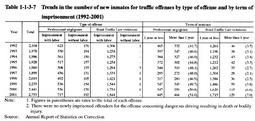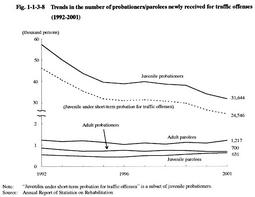| Previous Next Index Image Index Year Selection | |
|
|
2 Disposition and treatment of traffic-related offenders (1) Disposition by public prosecutors offices Fig. 1-1-3-5 shows the percent distribution of persons finally disposed by public prosecutors offices in 2001, classified into general offenses (penal code offenses excluding professional negligence in traffic accidents and special law offenses excluding road traffic violations) and traffic-related offenses, by type of disposition. The rate of requesting formal trials for professional negligence in traffic accidents is far lower than that for general offenses. This is due to the fact that we should not rely only on penal punishments for the prevention of traffic accidents, and that it is not appropriate that most nationals can be subject to criminal penalty for petty cases in light of the original purpose of the penalty system in these days when a car-oriented society is developed and almost all nationals have driving licenses, and along with the diffusion of car insurance, medical expenses and repair costs coming to be compensated by car insurance in many cases. On the other hand, concerning road traffic violations as well as professional negligence in traffic accidents, the rate of requests for formal trials is also far lower than general offenses, but the rate of requests for summary orders is very high.
(2) Disposition by courts Fig. 1-1-3-6 shows the percent distribution of the imprisonment term for persons sentenced to imprisonment with or without labor for professional negligence and violation of the Road Traffic Law by ordinary first instance courts in 2001. As for professional negligence, 17.0% of persons sentenced to imprisonment with or without labor were not granted a suspended sentence, and imprisonment term for 1 year or more but less than 2 years had the highest share. Regarding violation of the Road Traffic Law, 19.8% of persons sentenced to imprisonment with or without labor were not granted a suspended sentence, and imprisonment term for less than 6 months had the highest share.
In 2001, for professional negligence in traffic accidents, 160 persons were sentenced to fines by ordinary first instance and 92,774 to fines by summary proceedings. For violations of the Road Traffic Law, 338 persons were sentenced to fines by ordinary first instance and 754,827 to fines by summary proceedings. Fig. 1-1-3-5 Percent distribution of persons finally disposed by public prosecutors offices by type of disposition (2001) Fig. 1-1-3-6 Percent distribution of the term of imprisonment for professional negligence and violation of the Road Traffic Law by ordinary first instance courts (2001) (3) Correction and rehabilitation of traffic offenders Table 1-1-3-7 shows the trends in the number of newly imprisoned offenders convicted of traffic offenses (professional negligence or violation of the Road Traffic Law) over the last decade. The number of newly imprisoned offenders convicted of traffic offenses started rising in 1998, and increased by 12.8% from the previous year in 2001, among which 33.0% were for professional negligence, and 67.0% were for violation of the Road Traffic Law. By sentence terms, imprisonment for more than 1 year was given to 50.0% of all inmates for professional negligence, but only 7.0% for violation of the Road Traffic Law. As for inmates sentenced for either professional negligence or violations of the Road Traffic Law violations, the percentage of imprisonment of more than 1 year has slightly increased in recent years.
Additionally, about half of those newly convicted of traffic offenses are detained in 6 designated facilities nationwide, including the Ichihara Prison, where in principle, living rooms, dining halls, and workshops are not locked, and body searches are not conducted on inmates. Furthermore, no escorts are present on the prison premises, and interviews are allowed without the presence of guards as often as possible. Traffic offenders detained in these prisons are adult inmates who are deemed suitable for open treatment and meet the following requirements: (i) They are not simultaneously serving a sentence of imprisonment with labor for any non-traffic offense; (ii) They have never been imprisonment for any non-traffic offense; (iii) The term of their sentence is about 3 months or more; and (iv) No physical or mental disorder has been identified. Fig. 1-1-3-8 shows the trends in the number of probationers/parolees newly received for traffic offenses (professional negligence or violation of the Road Traffic Law) by probation/parole type over the last 10 years. For each type of probation/parole, the number of persons newly received has been leveling off or slightly decreasing. Of total probationers/parolees for all offenses in 2001, 45.5% were for traffic offense probationers/parolees. In particular, 64.0% of total juvenile probationers/parolees were for traffic offenses. Therefore, the treatment of probationers/parolees for traffic offenses takes a relatively important role in the rehabilitation service in Japan (Regarding the short-term probation for traffic offenses, see Part 4, Chapter 2, Section 6 ). Table 1-1-3-7 Trends in the number of new inmates for traffic offenses by type of offense and by term of imprisonment (1992-2001) Fig. 1-1-3-8 Trends in the number of probationers/parolees newly received for traffic offenses(1992-2001) |



